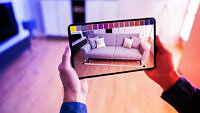How AR technology can optimize product development
The use of augmented reality not only leads to better results when it comes to the user experience. In product development as well, AR technologies are gaining ground and come with significant advantages.

Importance of VR and AR for business is growing rapidly
VR and AR technologies will permanently change the face of product development. As shown by the latest analysis conducted by PricewaterhouseCoopers (PwC), “Seeing is believing – How VR and AR will transform business and the economy”, the importance of virtual reality and augmented reality is growing rapidly in the business world:
From a niche phenomenon to an influential future technology: according to PwC, all industries can benefit from using augmented and virtual reality because they greatly simplify the development of products and services. Digital visualizations not only make it possible to organize processes and workflows more efficiently, but also to significantly improve human collaboration.
AR enables location-independent interactions with products
Whether it be globally distributed teams or prolonged crises such as the current coronavirus pandemic, a product’s market launch can be delayed or associated with greater risks if face-to-face contact is not possible. Augmented reality applications offer a practical and efficient solution in this respect and allow everyone involved in the project to interact with the product using a smart device, no matter where they are. So close you can almost touch it – AR lets developers do things such as:
- Visualize virtual objects anywhere in the world
- Walk around or step inside 3D models
- Examine details close up and from all angles
- Visualize and compare different states and variants of a model
- Provide feedback
- Make adjustments flexibly and in real time
More flexibility and less hassle and expense when developing prototypes
The last point in particular reveals a major advantage of virtual prototypes over conventional ones. Not only can further developments, design changes, or technical variations be implemented and depicted realistically using AR technologies, but they can also be shared in real time with the entire project team. Physical models, on the other hand, first have to be manually constructed and sent to different locations for joint discussions. They are also a lot less versatile and thus require several versions, for example if there are different customer specifications or color variants.
Here, augmented reality allows different ideas, approaches, and designs to be tested in the relevant context in the early stages of product development before the first real prototype has even been created. Due to the digital predevelopments, the prototype will then already be significantly more sophisticated, thereby further accelerating the product development process. Consequently, virtual AR prototypes not only facilitate collaboration within a team, but also considerably increase efficiency in terms of manufacturing time and costs.
Efficiently optimizing products by identifying flaws early on
As extensive analyses and checks can be conducted on realistic 3D models, potential flaws, errors, and technical imperfections can be identified and rectified in the early stages of development. AR technologies also offer a suitable environment for risk-free test scenarios, which help optimize the product in a digital space. The virtual twins thus make it possible to directly assess the effects of any changes made, identify potential weaknesses, and develop best practice solutions.
AR technologies don’t just help development teams
Another one of AR’s major strengths in this context is that concept ideas, technical specifications, or different design ideas can also be presented to other departments, the management team, investors, or other stakeholders in a particularly vivid and realistic way. Especially in the case of complex structures or large-scale facilities in the industrial sector, AR technologies give potential customers a much better idea of the finished product and how it will be integrated into its surroundings. As practical tools for presentations and sales measures, augmented reality applications therefore ensure efficient mutual dialogue even beyond the development team itself.
The benefits of augmented reality for product development at a glance
- Shorter development time thanks to more effective planning and more extensive analysis options
- Reduced development costs
- Can be used in the early stages of development
- Increased safety, since risks are minimized
- Improved collaboration through joint access to all relevant data and information in real time
- Efficient product optimization through early identification and rectification of flaws and errors
- Visualization of current projects for external departments, business partners, and customers





